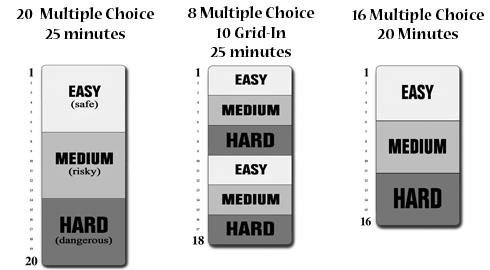Introduction to the SAT Math Test
Page 2
SAT Math Is Way Different from School MathThe SAT Math Test is remarkably different from the kind of math tests you're used to taking in school. As I said in The SAT Is Not Like Your School Tests: if you take the SAT Math Test the way you're used to taking math tests in school, you're in for a rude surprise. Consider the following differences:
- The SAT Math Test is a multiple-choice test; you receive no partial credit for your work if the solution isn't correct. In school if your math solution is "mostly correct," you will probably receive close to full credit even if your exact answer is off the mark. Not on the SAT. On the SAT, if you're even a bit off the answerfor whatever reasonyou'll lose full credit for that question. This difference is huge, and will completely reverse your priorities from being quick and clever (but sometimes sloppy) on school tests, to being ruthlessly, obsessively accurate on the SAT.
- SAT math questions are all worth the same amount. Again, this will completely upend your usual priority on school math tests to spend the most amount of time on the most difficult questions. On a school test you can't afford to miss a difficult question (because it's usually worth a lot of points). On the SAT Math Test, you can't afford to miss an easy question.
- SAT math questions are in order of difficulty. On school math tests this is often the case, but remember that the later questions on those tests are worth more. You have been trained, in other words, to sprint in the early part of a test so that you can spend enough time on the questions that count more near the end. On the SAT, you should do exactly the reverse: go slowly on the easy and medium questions in the early part, and then sprint on the hardest questions at the end.
- The SAT Math Test covers a hodgepodge of material. Yet again, this aspect will require a much, much larger adjustment of their problem-solving methods than most students realize. When you're studying a math topic in schoolsay, solving simultaneous equationsyou can expect that your quiz or test on that material will involve just simultaneous equations. Granted, sometimes your math teacher may make a test cumulative, but even then the test will cover relatively recent material. On the SAT, one question can be on percentages that you studied back in junior high, followed by an algebra II question on material you may have studied last year, bouncing back to geometry you covered a year or two ago, and continuing all over the place. The SAT Math Test requires that you orient yourself instantaneously to each new question, and then leap nimbly to the next question, reorienting yourself all over again.
Not all of these differences make the SAT more difficult; indeed, some of these differences will give you powerful leverage. But these differences will require a complete overhaul in the way you approach solving math questions.
SAT Math Questions Are Arranged in Order of Difficulty
Each math section is arranged in order of difficulty. Here's the question layout of the entire SAT Math Test:
 |
You won't see warning signs in your booklet like this: Warning! You are about to leave the medium questionshard questions coming up! The only clue you'll have regarding the difficulty of a question is where in its section it appears, so you'll have to keep an eye open for the question number at all times.
The only exception to this rule about order of difficulty (danger) occurs on compound questions. Your SAT Math Test may have two or three consecutive questions based on the same information. If so, the second and third ones will be medium to hardregardless of where these questions appear in the section.
Normally, for example, questions 10 and 11smack in the middle of a 20-question section would be medium questions. If this were a pair of questions on the same information, however, the first question would be medium and the second question would be difficult. If it were a trio of questions on the same informationsay, 10, 11, and 12the first question would be easy, the second question would be medium, and the last question would be difficult. Not a big deal since these compound questions appear maybe once every SAT, but worth watching out for.
Stay alert! Every once in a while, a difficult question gets dropped into the medium "area." You won't, however, find an easy question in the difficult area at the end of a section.